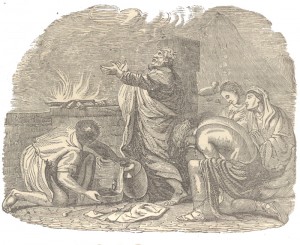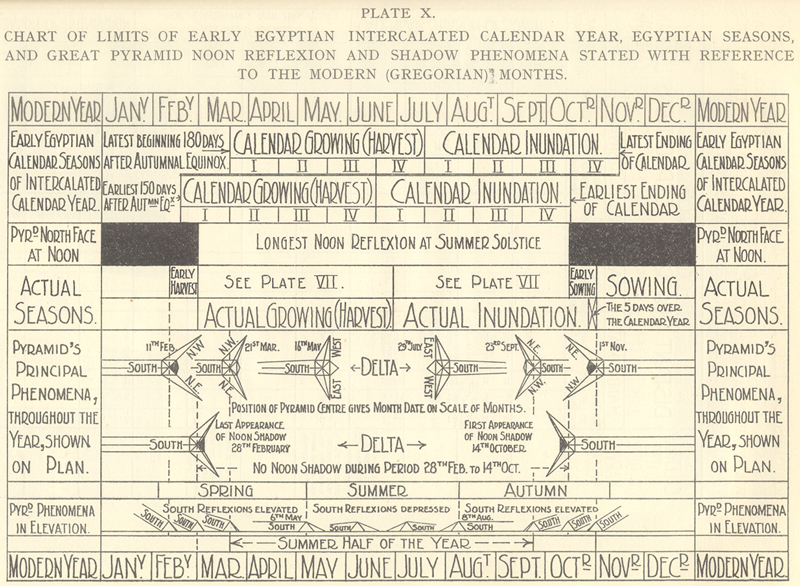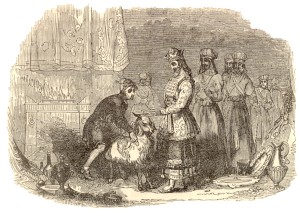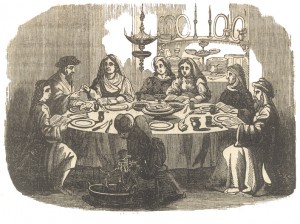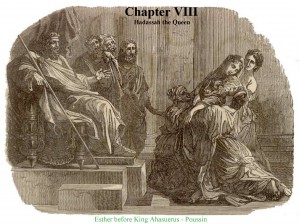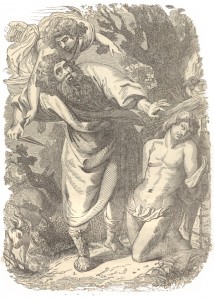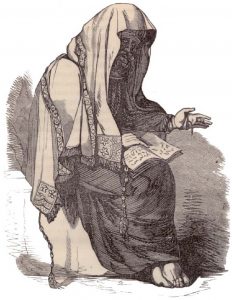 To this day one of the most important, yet least understood aspects of Bible prophecy is the history of Ezra, Nehemiah and their contemporary, the great Persian king “Artaxerxes”. Even less understood is how this history has shaped Continue reading
To this day one of the most important, yet least understood aspects of Bible prophecy is the history of Ezra, Nehemiah and their contemporary, the great Persian king “Artaxerxes”. Even less understood is how this history has shaped Continue reading
Category Archives: Biblical History
26 Questions
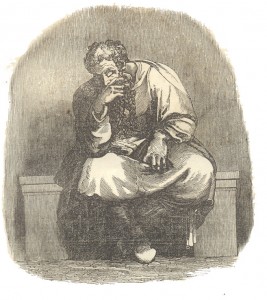 Did you know there are hundreds of books written about the prophecy of Daniel 9? I’ve enjoyed reading many of them over the past 25 years but surprisingly, no matter what position is taken on the prophecy of 70 Weeks, nearly all the books have one deficiency in common. What I’m talking about is a total disregard for establishing the starting point of the prophecy of 70 Weeks on a reasonable Biblical foundation in the chronology of the 2nd temple era.
Did you know there are hundreds of books written about the prophecy of Daniel 9? I’ve enjoyed reading many of them over the past 25 years but surprisingly, no matter what position is taken on the prophecy of 70 Weeks, nearly all the books have one deficiency in common. What I’m talking about is a total disregard for establishing the starting point of the prophecy of 70 Weeks on a reasonable Biblical foundation in the chronology of the 2nd temple era.
This may not seem like a big deal to some of you but Daniel 9 and the 70 Weeks prophecy influences how we see the Messiah Yeshua, the Antichrist, and much of the timing found in the book of Daniel and Revelation. No prophecy in the Bible has had more influence on our futurist understanding of end time events than Daniel 9 and the 70 Weeks. That being said, wouldn’t one of our most basic responsibilities as Bereans be to established this prophecy on a rock solid Biblical foundation? I believe it would.
For those of you’ who would like to see how well you’ve laid your foundation for the prophecy of 70 Weeks, I’ve come up with Continue reading
Are 2015, 2016, or 2017 Jubilee Years?
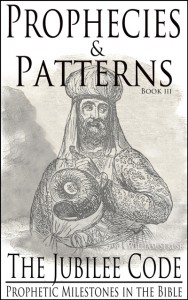 The Biblical jubilee has gained a substantial amount of attention in Bible prophecy circles the last few years causing some to speculate that the years 2015, 2016, or 2017 might in fact be a Jubilee year. Books, like Jonathan Cahn’s: Mystery of the Shemitah or Gidon Ariel and Bob O’Dell’s: Israel First!, really got people thinking about the jubilee and Sabbath cycles as they relate to the Bible’s prophetic record. While this attention to the subject is welcome and needed, there still remains Continue reading
The Biblical jubilee has gained a substantial amount of attention in Bible prophecy circles the last few years causing some to speculate that the years 2015, 2016, or 2017 might in fact be a Jubilee year. Books, like Jonathan Cahn’s: Mystery of the Shemitah or Gidon Ariel and Bob O’Dell’s: Israel First!, really got people thinking about the jubilee and Sabbath cycles as they relate to the Bible’s prophetic record. While this attention to the subject is welcome and needed, there still remains Continue reading
41 Generations to the Messiah
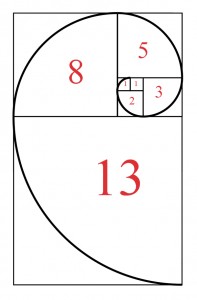
Fibonacci Sequence
One of my favorite prophetic passages in the Bible is found in Isaiah 46:9-10. It’s a statement by YHWH, the living God of the Bible, that He is God and there is none like Him. In this wonderful passage, YHWH is talking to Israel contrasting Himself with the Babylonian gods, Bel and Nebo, which had been unable to save ancient Babylon and its inhabitants from captivity.
To whom will ye liken me, and make me equal, and compare me, that we may be like?…
Remember the former things of old: for I am God, and there is none else; I am God, and there is none like me, Declaring the end from the beginning, and from ancient times the things that are not yet done, saying, My counsel shall stand, and I will do all my pleasure: Isaiah 46:5, 9-10
Did you catch that? The first evidence YHWH uses to prove to Israel that Bel and Nebo are not His equals is the fact that He tells the end from the beginning. In other words He knows the future. This foreknowledge of the future is one way YHWH sets Himself apart from other gods and elevates the Bible above other religious texts. Continue reading
The Unknown God
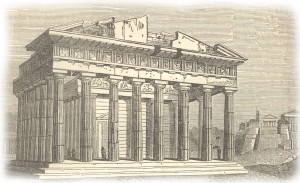 Each time Friday the 13th rolls around I can’t help but think of the Apostle Paul and his speech to the men of Athens. By all accounts, Paul was quite a character. I can just picture him standing on the ancient Areopagus (Mars Hill) of Athens nearly two thousand years ago calling out to those gathered at the famous altar to the Unknown God:
Each time Friday the 13th rolls around I can’t help but think of the Apostle Paul and his speech to the men of Athens. By all accounts, Paul was quite a character. I can just picture him standing on the ancient Areopagus (Mars Hill) of Athens nearly two thousand years ago calling out to those gathered at the famous altar to the Unknown God:
“Ye men of Athens, I perceive that in all things ye are too superstitious.”
I admit, I would like to have been there for that speech. To see Paul in his billowing robes challenging the highly educated Atheneans about their unfounded superstitions would have been quite a sight. Anyway, Paul goes on to explain to the men of Athens that the God they ignorantly worship was the living God of the Bible.
If the Apostle Paul was here today, I can just see him chiding our generation with similar advice. Let’s take the number 13 for example. Even among Christians this number has a certain evil connotation about it. Have you ever wondered why the number 13 has such a superstitious aura? What if I told you, that like the ignorance of those men of Athens concerning the altar to the Unknown God, the superstitions surrounding the number 13 are but the vestiges of a similar story that involves that same “Unknown God”? Continue reading
The Flood & the Coming Messiah
In my last blog post, Halloween and the Bible, we looked at the fascinating history of Halloween and the flood of Noah. Today I want to share with you how those events are related to Israel’s exodus from Egypt, the Biblical calendar, and the promise of the coming Messiah. David Jesse, a blogger I read, has a saying which I really love. He says “Context makes the Bible come alive”. Today I want to share with you some unique historical facts about Egypt and Israel’s exodus in the hope that this information will make the Bible come alive for you in a new way.
The Descendants of Seth
First let’s travel back to the time of Christ and a Jewish historian named Josephus. Nearly two thousand years ago Josephus had this to say about the flood:
Now this Seth, when he was brought up, and came to those years in which he could discern what was good, became a virtuous man; and as he was himself of an excellent character, so did he leave children behind him who imitated his virtues…
They also were the inventors of that peculiar sort of wisdom which is concerned with the heavenly bodies, and their order. And that their inventions might not be lost before they were sufficiently known, upon Adam’s prediction that the world was to be destroyed at one time by the force of fire, and at another time by the violence and quantity of water, they made two pillars, {e} the one of brick, the other of stone:
they inscribed their discoveries on them both, that in case the pillar of brick should be destroyed by the flood, the pillar of stone might remain, and exhibit those discoveries to mankind; and also inform them that there was another pillar of brick erected by them. Now this remains in the land of Siriad [Egypt] to this day…. (Antiquities of the Jews 1:68-71)
Interestingly in Isaiah 19:19 such a pillar is mentioned in the land of Egypt in a future messianic context. Here take a look:
In that day shall there be an altar to YHWH in the midst of the land of Egypt, and a pillar at the border thereof to YHWH. And it shall be for a sign and for a witness unto YHWH of hosts in the land of Egypt: for they shall cry unto YHWH because of the oppressors, and he shall send them a saviour, and a great one, and he shall deliver them. (Isaiah 19:19-20)
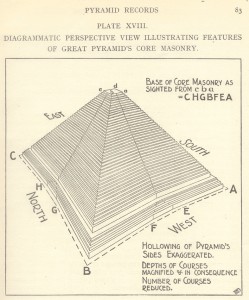 You see, nearly two thousand years ago the Great Pyramid in Egypt was already considered a monument built by the descendants of Seth to monumentalize a warning to mankind that judgement was coming. Some even claim this pillar has messianic significance. A discussion of whether this tradition is true or not will have to wait for another article, but we do know from the evidence of the Great Pyramid itself, that it was built in such a way that it marked the first day of November (and the Flood) in a very special way. I’ll get to that in a moment, but first let me describe this monument in a little more detail. For context’s sake keep in mind that Goshen, where the children of Israel lived for several hundred years, was only fifty miles or so from this great monument. In a moment you will see why the Great Pyramid was known to the ancient Egyptians as Ta Khut “The Light” and why it is still one of the greatest manmade wonders of the world.
You see, nearly two thousand years ago the Great Pyramid in Egypt was already considered a monument built by the descendants of Seth to monumentalize a warning to mankind that judgement was coming. Some even claim this pillar has messianic significance. A discussion of whether this tradition is true or not will have to wait for another article, but we do know from the evidence of the Great Pyramid itself, that it was built in such a way that it marked the first day of November (and the Flood) in a very special way. I’ll get to that in a moment, but first let me describe this monument in a little more detail. For context’s sake keep in mind that Goshen, where the children of Israel lived for several hundred years, was only fifty miles or so from this great monument. In a moment you will see why the Great Pyramid was known to the ancient Egyptians as Ta Khut “The Light” and why it is still one of the greatest manmade wonders of the world.
Now let me paint you a picture of the Great Pyramid as it was during the time of Israel’s sojourning in Egypt. The base of the Great Pyramid was 365.24 cubits squared covering 13 acres. This stone structure was laid out in relation to the cardinal points of the compass with the precision of a modern observatory. Its base circumference was 36,524 inches and its height was 5813 inches or nearly 484 feet. Quite literally, it was a manmade mountain. For perspective, you could take the stone mass of the Great Pyramid and it would make a wall one foot thick and four feet high stretching from New York to San Francisco. Now that is big!
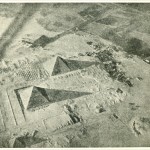 What really stood out about the Great Pyramid was its covering. The four slightly concave triangular sides of this incredible monument were covered with a casing of pure white polished limestone and fitted with such precision that even today engineers and archeologists have no conclusive idea how the task was accomplished. Oddly enough, the capstone or ‘head corner stone’, as it might be called in Biblical terms, was never placed on the Great Pyramid. In antiquity it was considered a stone rejected by its builders.
What really stood out about the Great Pyramid was its covering. The four slightly concave triangular sides of this incredible monument were covered with a casing of pure white polished limestone and fitted with such precision that even today engineers and archeologists have no conclusive idea how the task was accomplished. Oddly enough, the capstone or ‘head corner stone’, as it might be called in Biblical terms, was never placed on the Great Pyramid. In antiquity it was considered a stone rejected by its builders.
The Greek historian, Diodorus Siculus, observed that in his day (56-60 BC) the Great Pyramid was complete without any decay, but it lacked its capstone. (Diodorus Siculus, Book I, 63.4-64.14)
The Greek geographer Strabo who lived as a contemporary of Siculus is said to have stated that, “It seemed like a building let down from heaven without the aid of human hands.”
So we have a massive manmade structure with highly reflective sides fixed precisely to the cardinal points of the compass. This arrangement then produced reflective beams of lights and shadows marking the limits of the astronomical year with a brilliant display, hence the Egyptian title, “The Light”. Among its many characteristics the Great Pyramid was in fact an astronomical almanac. This purposeful design marked the 1st of November and the sowing season with a specific reflective effect which was used by the Egyptians to begin their agricultural cycle as well as their New Year. The chart below comes from Davidson’s Pyramid Records and it shows what the children of Israel likely saw during their captivity. In the far right of the chart note the reflective design which was seen on the 1st of November.
So okay, this is all a neat bit of history you might be thinking, but what does this have to do with Israel? Well, this is where it gets really amazing in my opinion. The Great Pyramid defined Egypt’s agricultural calendar and seasons with its reflective effect. This was the calendar system under which all Egypt operated during Israel’s captivity, one which reminded them of a great destruction of mankind.
After the exodus of Israel from Egypt one of the first things YHWH did was change Israel’s calendar from what they were familiar with in Egypt to a new calendar which began in the spring and commemorated the events of the Exodus.
And YHWH spake unto Moses and Aaron in the land of Egypt, saying, This month shall be unto you the beginning of months: it shall be the first month of the year to you. Speak ye unto all the congregation of Israel, saying, In the tenth day of this month they shall take to them every man a lamb, according to the house of their fathers, a lamb for an house;
…And ye shall keep it up until the fourteenth day of the same month: and the whole assembly of the congregation of Israel shall kill it in the evening. And they shall take of the blood, and strike it on the two side posts and on the upper door post of the houses, wherein they shall eat it…. And thus shall ye eat it; with your loins girded, your shoes on your feet, and your staff in your hand; and ye shall eat it in haste: it is YHWH’s passover. (Exodus 12:1-11)
Thou shalt keep the feast of unleavened bread: (thou shalt eat unleavened bread seven days, as I commanded thee, in the time appointed of the month Abib; for in it thou camest out from Egypt: and none shall appear before me empty:) (Exodus 23:15)
You see, Israel, while in slavery to Egypt (which can also be seen as a symbol of mankind’s slavery to sin), kept a calendar which immortalized the righteous judgment of God on a sinful world. After the exodus, YHWH directed Israel’s focus away from a remembrance of the flood and towards a calendar which celebrated their deliverance from Egypt and foreshadowed their redemption through the coming Messiah. A messiah who became “the lamb of God which taketh away the sins of the world.” Now how awesome is that!
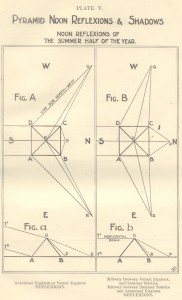 The Ark and Deliverance
The Ark and Deliverance
But there is more. Remember how the Bible describes the flood as occurring on the 17th day of the second month of the pre-flood calendar, a day which modern tradition observes in ignorance as Halloween. Have you ever thought about the day Noah’s ark finally rested on the mountains of Ararat? Well, that day was just as symbolically important? Here take a look:
And the waters returned from off the earth continually: and after the end of the hundred and fifty days the waters were abated. And the ark rested in the seventh month, on the seventeenth day of the month, upon the mountains of Ararat. (Genesis 8:3-4)
Yes indeed, the ark rested on a date which YHWH, hundreds of years later, would commemorate as Feast of Unleavened Bread. So in wonderful prophetic symbolism Noah and his family were delivered from the flood on the 17th day of the 7th month which according to Israel’s religious calendar after the exodus became the 17th day of the1st month. In modern calendar terms this would be our March or April. In other words, the ark rested on the mountains of Ararat on the same day in which Israel was delivered from Egyptian bondage. Then over a millennium later on that very same day, Yeshua the promised Messiah, rose from the grave and became the firstfruits of them that slept, thus delivering mankind from their bondage to sin.
But now is Christ risen from the dead, and become the firstfruits of them that slept. For since by man came death, by man came also the resurrection of the dead. For as in Adam all die, even so in Christ shall all be made alive. But every man in his own order: Christ the firstfruits; afterward they that are Christ’s at his coming. (1 Corinthians 15:20-23)
You see, the Israel that lived in the shadows and reflections of the Great Pyramid was only reminded of the judgment of God. The Israel that left Egypt was given the promise of a coming redeemer. How’s that for a new perspective on the Flood and the Exodus!
The Flood and Daniel 9
The above context provides a rather unique perspective on Israel’s calendar system and the promised Redeemer but there is another aspect to the flood story and the Messiah. In Daniel 9 we have the most important messianic prophecy in the Bible. Commonly called the Prophecy of 70 Weeks, its importance lies in the fact that it is the only prophecy in the entire Bible which gives a specific and datable timeline for the coming of the Messiah.
Daniel 9:25 tells us that after 7 “weeks” the Messiah will come. Keep in mind that the term weeks in Daniel 9 comes from the Hebrew Shabuwa and simply means sevens. The period of time intended by the prophecy is never stated.
Know therefore and understand, that from the going forth of the commandment to restore and to build Jerusalem unto the Messiah the Prince shall be seven weeks [sevens],… (Daniel 9:25a)
I won’t go into all the details in this article, but in Daniel 9:26 the prophecy goes on to tell us that the Messiah will be “cut off”. We know in retrospect from both the Old and New Testaments that the Messiah would have a dual role in the affairs of mankind. He would be both a suffering servant as described in Isaiah 53 and a future king as described in Luke 1:31-33. Here in Daniel 9:26 though we have a description of the Messiah as a suffering servant.
And after threescore and two weeks shall Messiah be cut off, but not for himself: (Daniel 9:26a)
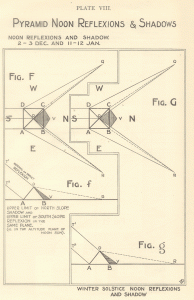 Notice in the passage above, it says that the Messiah will be “cut off, but not for himself”. This is where we find an amazing connection between the promised Messiah and the flood of Noah’s day. You see the term “cut off” in Daniel 9:26 comes from the Hebrew karath which means to cut off or cut down. As many scholars have noted over the years, the first occurrence of a Hebrew word in the Bible often provides additional insights into its meaning. Here in Daniel 9:26 we find such an example because the first occurrence of the work karath comes to us from the flood story.
Notice in the passage above, it says that the Messiah will be “cut off, but not for himself”. This is where we find an amazing connection between the promised Messiah and the flood of Noah’s day. You see the term “cut off” in Daniel 9:26 comes from the Hebrew karath which means to cut off or cut down. As many scholars have noted over the years, the first occurrence of a Hebrew word in the Bible often provides additional insights into its meaning. Here in Daniel 9:26 we find such an example because the first occurrence of the work karath comes to us from the flood story.
And I will establish my covenant with you; neither shall all flesh be cut off [karath] any more by the waters of a flood; neither shall there any more be a flood to destroy the earth. (Genesis 9:11)
Take a moment to read Daniel 9:26a once again. Notice it says the Messiah will be karath “but not for himself”. Contrast that with Noah’s day were we are told that nearly all mankind was cut off (karath) because of their sins. In Noah’s day mankind paid the required price for their sins. Daniel prophesied that a day would come when the Messiah would pay that price (karath) in place of mankind, it was his blood which would atoned for the sins of humanity.
Not for Himself indeed!
Let me give you a few examples from the Biblical record illustrating how the Messiah was cut off for the sins of mankind:
Surely he hath borne our griefs, and carried our sorrows: yet we did esteem him stricken, smitten of God, and afflicted. But he was wounded for our transgressions, he was bruised for our iniquities: the chastisement of our peace was upon him; and with his stripes we are healed. (Isaiah 53:4-5)
And one shall say unto him, What are these wounds in thine hands? Then he shall answer, Those with which I was wounded in the house of my friends. (Zechariah 13:6)
So Christ was once offered to bear the sins of many; and unto them that look for him shall he appear the second time without sin unto salvation. (Hebrews 9:28)
For Christ also hath once suffered for sins, the just for the unjust, that he might bring us to God, being put to death in the flesh, but quickened by the Spirit: By which also he went and preached unto the spirits in prison; Which sometime were disobedient, when once the longsuffering of God waited in the days of Noah, while the ark was a preparing, wherein few, that is, eight souls were saved by water. The like figure whereunto even baptism doth also now save us (not the putting away of the filth of the flesh, but the answer of a good conscience toward God,) by the resurrection of Jesus Christ: Who is gone into heaven, and is on the right hand of God; angels and authorities and powers being made subject unto him. (1 Peter 3:18-22)
Did you catch the analogy Peter made above? The same waters which “baptized” the world and removed sin also lifted the ark and brought deliverance from the death. In a like manner it was Yeshua’s resurrection which brings salvation and deliverance from sin.
And the waters prevailed, and were increased greatly upon the earth; and the ark went upon the face of the waters. (Genesis 7:18)
Therefore we are buried with him by baptism into death: that like as Christ was raised up from the dead by the glory of the Father, even so we also should walk in newness of life. (Romans 6:4)
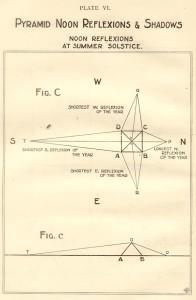 The Flood and the Messiah
The Flood and the Messiah
So next time you’re thinking about Israel and their exodus from Egypt remember the last surviving wonder of the ancient world. Remember a monument which Strabo described as, “…a building let down from heaven without the aid of human hands.” A megalithic wonder which reminded all Egypt of YHWH’s judgment on a sinful world. A monument which in its own way points mankind to the promise of a coming redeemer.
In that day shall there be an altar to YHWH in the midst of the land of Egypt, and a pillar at the border thereof to YHWH. And it shall be for a sign and for a witness unto YHWH of hosts in the land of Egypt: for they shall cry unto YHWH because of the oppressors, and he shall send them a saviour, and a great one, and he shall deliver them. (Isaiah 19:19-20)
A Berean’s Challenge
For those Bereans out there who love to dig deeper into YHWH’s word, I have a challenge for you. In Daniel 9 there are three Hebrew words which the Bible first uses in describing the events of the flood. We already looked at the word karath which was used to describe mankind being “cut off” from the earth. The other two words are gabar (prevail) and beriyth (covenant). It was no accident that all three of these words found in Daniel 9 are first found in the flood story and the destruction of mankind. See if you can find the connection.
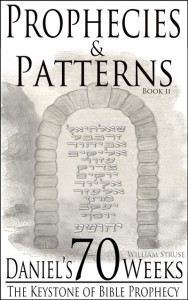 YHWH willing, in a couple of weeks I will be releasing Book II in my Prophecy and Patterns series, Daniel’s 70 Weeks: The Keystone of Bible Prophecy. In the book we’ll search for an answer to these intriguing questions and many others as well. Remember if you are a blog subscriber you’ll receive a complimentary digital copy of the book when it is released. In the meantime, I hope you enjoy your own Biblical treasure hunt for the wonders YHWH has hidden for us to find.
YHWH willing, in a couple of weeks I will be releasing Book II in my Prophecy and Patterns series, Daniel’s 70 Weeks: The Keystone of Bible Prophecy. In the book we’ll search for an answer to these intriguing questions and many others as well. Remember if you are a blog subscriber you’ll receive a complimentary digital copy of the book when it is released. In the meantime, I hope you enjoy your own Biblical treasure hunt for the wonders YHWH has hidden for us to find.
It is the glory of God to conceal a thing: but the honour of kings is to search out a matter. (Proverbs 25:2)
Authors note: All the charts in this article come from Davidson’s Pyramid Records (1924)
Halloween and the Bible
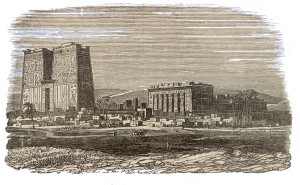 The Spanish poet and philosopher George Santayana wisely observed, “Those who cannot remember the past are condemned to repeat it.” Each year about this time the truth of this statement hits me just little bit more. To me, it is truly sobering to realize just how much of the past we have forgotten. Despite what we’d like to believe, human nature has not changed much over the past 6000 years.
The Spanish poet and philosopher George Santayana wisely observed, “Those who cannot remember the past are condemned to repeat it.” Each year about this time the truth of this statement hits me just little bit more. To me, it is truly sobering to realize just how much of the past we have forgotten. Despite what we’d like to believe, human nature has not changed much over the past 6000 years.
You see it’s about this time of year, (it gets a little earlier each year) that we see preparations for the celebration of Halloween. Ironically, (and you will see the irony by the end of this article) Halloween is the one holiday which increasingly numbers of people are celebrating regardless of religious or non-religious affiliations. It’s a day which emphasizes darkness, horror, and death juxtaposed with innocent and increasingly not so innocent revelry and fun.
For those of us with a Biblical world view, each year the discussion of whether it’s okay to celebrate Halloween becomes a bit more divisive. Those of you who are regular readers of this blog know I like to look at these things in terms of the Biblical record and ancient history. So today, I’m not going to tell you what to do about Halloween, but I will share with you a bit of little known history which just might change your perspective on this increasingly popular holiday. What I’m going to share with you is the origins of Halloween and how it so scarred the consciousness of mankind that nearly every ancient civilization has a record of it. In my blog post today I take you back nearly 4500 years to the most horror filled day in the history of mankind, a day when mankind nearly vanished from the face of the earth.
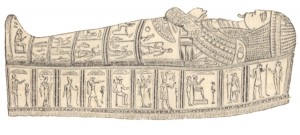 You and I know it as Halloween, All Saints Day, or the Day of the Dead, but as you are about to learn these celebrations all have a common origin in a real historical event. Today, you and I associate Halloween with ghosts, witches, wandering spirits, and lost souls. Many claim these celebrations are the result of the pagan practices of the Druids and Celts, but the truth is actually much further back in history.
You and I know it as Halloween, All Saints Day, or the Day of the Dead, but as you are about to learn these celebrations all have a common origin in a real historical event. Today, you and I associate Halloween with ghosts, witches, wandering spirits, and lost souls. Many claim these celebrations are the result of the pagan practices of the Druids and Celts, but the truth is actually much further back in history.
Did you know that Assyria, Babylon, Egypt, Peru, Australia, India, Polynesia, Mexico, and Europe all have their own traditions concerning a destruction of mankind? Traditions do vary, but beginning in the fall, towards the end of our modern calendar month of October, many cultures of the world commemorate this event.
One of the best summaries of the subject, that I’ve ever read, was written at the turn of the century by David Davidson.1 Though, I don’t agree with all of Davidson’s conclusions, the historical references that he provides related to the great destruction of mankind are well worth considering. This is a rather lengthy quote, but worth the effort:
* * *
Ҧ 25. THE FESTIVAL OF THE DEAD.
Attention has been directed (in ¶15) to the fact that the 1st November dating was intentionally observed instead of the beginning of Winter, seven days later. The 1st November Pyramid phenomena defined the first day of the fixed agricultural year of the Ancient Egyptians. It is with respect to this fixed 1st November year that the early Egyptian Calendar year was intercalated at the end of every five or six years. Hence the festival of the true beginning of the New Year was observed in Egypt at intervals of this duration as early as the time of Dynasties I and II.3
At the time of Dynasty XII, the celebration of the New Year festival took the form of lighting lamps for the dead on the last day of the old year and the first day of the New Year.4 As Dr. Frazer has pointed out, this proves that the New Year’s Festival at this time was the ancient Festival of the Dead—the modern All Souls’, or All Saints’ (1st – 2nd November).5
“The custom,” he remarks,6 “was observed throughout the whole of Egypt,” and is referred to by Herodotus (II, 62), as prevailing in the 5th Century B.C.” “On All Saints’ Day, the 1st of November,” Frazer continues, “ the shops and streets in the Abruzzi are filled with candles, which people buy in order to kindle them in the evening on the graves of their relations : For all the dead come to visit their homes on that night, the Eve of All Souls’, and they need lights to show them the way.”
Similarly, he states, “The Miztecs of Mexico believed that the souls of the dead came back in the twelfth month of every year, which corresponded with our November. On this day of All Souls the houses were decked out to welcome the Spirits.8
Frazer suggests that “The nominally Christian feast of All Souls’ on November 2nd, appears to be an old Celtic festival of the Dead, adopted by the Church in 998 A.D.” “The Celts and the Teutons appear to have dated the beginning of their year from the beginning of Winter, the Celts reckoning it from the 1st of November and the Teutons from the 1st of October. “ The feast of All Saints’ on November 1st, seems also to have displaced a heathen festival of the dead.”9
¶ 26. OSIRIS AND THE FESTIVAL OF THE DEAD: ISIS AND THE GREAT PYRAMID
In the dual aspect of Osiris as corn or vegetation-god and god of the dead, the rites of Osiris embodied in one celebration, at the commencement of the November Vegetation Year, the rites of the agricultural deity and the rites of primitive ancestor-worship. In the sowing of the grain in November was seen the symbolic burial of the god ; in its growth, his renewal of life ; his resurrection ; and, in harvest, the death and sacrifice of the god.10 Thus Dr. Frazer states :11
“ Under the names of Osiris, Tammuz, Adonis, and Attis, the peoples of Egypt and Western Asia represented the yearly decay and revival of life, especially of vegetable life, which they personified as a god who annually died and rose again from the dead.”
The rites of Osiris in ancient Egypt were annually celebrated on the day of the Festival of the Dead, November 1st. Owing to the fact that the noon reflections of the Great Pyramid defined the day of the celebrations, Osiris, in later Egyptian times, was associated with the Pyramid. Hence the fact that Isis, the female counterpart of Osiris, was designated in later times, “ the queen of the Pyramid,” and the “ mistress of the commencement of the year.” When the November year was discarded for the Sothic or Sirius Year, Isis followed the alteration of the year’s beginning, and was identified with the star Sothis or Sirius. The original November year beginning aspect of the goddess was Hathor, later absorbed by Isis.
¶ 27. THE GREAT PYRAMID NOT AN INSTITUTION OF EGYPTIAN RELIGION.
The accounts of Herodotus that Cheops (or Khuphu), the builder of the Great Pyramid, closed the Egyptian temples of the gods, and forbade sacrifice to the gods, and of the Egyptian priest, Manetho, that the same king “was arrogant towards the gods,” have been confirmed by Professor Petrie’s excavations at Abydos.12 Furthermore, the simplicity of the Great Pyramid, and of other works belonging to the same reign, the utter lack of internal or external ornament and inscription, removes the Pyramid entirely from the particular kind of religious atmosphere associated generally with every form of Egyptian architecture.
It seems clearly obvious, then, that the First of November phenomena of the Great Pyramid had not been devised to ensure the celebration of the rites of ancestor-worship, or the rites of Osiris, on this particular day. The traditions concerning the festival, however, indicate that it was considered to be the anniversary of an historical event, rather than of an event belonging to the astronomical or vegetational phenomena of the year. This again, is confirmed by the Pyramid indicating this date rather than the true beginning of winter.
¶ 28. THE TRADITIONAL ORIGIN OF THE FESTIVAL OF THE DEAD.
As to the origin of the traditions concerning the festival of the dead, Haliburton13 states as follows :— In Mexico “ the festival of the dead was held on the 17th of November, and was regulated by the Pleiade. They had a tradition that, at that time, the world had been previously destroyed, and they dreaded that a similar catastrophe at the end of a cycle would annihilate the race.”
The 17th of November14 occurs also as an alternative dating of certain cults in Egypt during Dynasties XII and XIX, in Ptolemaic Egypt, and at the time of Plutarch. It occurs in Ancient Rome as an alternative date to 1st November. According to Plutarch, the alternative dating, on the fixed Alexandrian (Julian) Calendar of his time, fell on the 17th day of the Egyptian month Athyr (Hathor).15 In the XIIth Dynasty, the same alternative dating would be the 17th day of Month I, Season of Sowing,—the 1st month of the fixed 1st November year.
Reference to the Egyptian form of the traditional destruction of the world appears in the early Xth Dynasty Papyrus, Petersburg III6A,16 as “The Destruction of Mankind.” The Xth Dynasty Papyrus states: “ God made heaven and earth (refer Gen. I, i) at their desire. He checked the greed of the waters (refer Gen. I, 6-10) and made the air to give life to their nostrils (i.e., by the removal of super-saturation from the atmosphere effected by process of Gen. I, 6 and 7. For previous conditions refer Gen. II, 5 and 6). They are His own images (refer Gen. I, 26, 27) proceeding from His flesh He slew His enemies and destroyed His own children because of their plots in making rebellion.” (Refer Gen. VI, 5-7, 11-13, for causes.)
The later form of the narrative, appearing in the tomb of Seti I of Dynasty XIX,17 associates Hathor with the “Destruction of Mankind,” which would account for the 17th day of the Egyptian month Hathor (the Athyr of Plutarch’s account) being identified, in later times, with the Festival of the Dead.
¶ 29. HATHOR AND “THE DESTRUCTION OF MANKIND.
” Outstanding features of the XIXth Dynasty story of the “Destruction of Mankind “ fix that narrative as the Egyptian rendering of the narrative of the Noachian flood in Genesis, and of the ancient Mexican tradition of the destruction of the world, referred to by Haliburton. Commemoration of the latter, as quoted, “ was regulated by the Pleiades.”
Confirming the connection between the various forms of the narrative, Haliburton observes that the celebration of the festival of the dead by the Australian aborigines was held in November, when the constellation of the Pleiades is most distinct, and was specifically worshipped as “ the giver of rain.”18 He says again that “ The month of November was formerly called in Persia ‘ The Month of the angel of death.’ “19
In the Egyptian XIXth Dynasty form of the tradition this “ angel of death “ appears as Hathor. Hat-hor, as Sir Ernest Budge shows,20 was originally ‘ Het-Heru,’ “ The House of Horus,” “ one special part of the great watery mass of heaven,” and was therefore a special part of “ the waters above the firmament,” of Genesis I, 9, and probably, therefore, the Deluge “ floodgates of heaven “ of Genesis VII, II. The latter should more clearly be rendered “ a finely spread restraining influence or natural law (attenuated lattice-work is the restricted application) upholding the waters above the firmament,” This sufficiently accounts for the 17th of the month Athyr (Hathor) being celebrated as the day of the festival of the dead in the Alexandrian Calendar period. For in the narrative of Genesis the Noachian deluge is given as beginning on the 17th day of the second month of the Calendar year of Genesis. As to the association between Hathor and the ancient November constellation of Pleiades, the modern popular name—”the seven sisters”—of the latter constellation had its counterpart in Ancient Egypt as “ the Seven Hathors.”
The XlXth Dynasty narrative of the Destruction of Mankind states that “Ra ordered in the midst of the night21 to pour out the water of the vessels, and the fields were entirely covered with water and there came the goddess (Hathor) at the morning, and she found the fields covered with water, and she was pleased with it and she drank to her satisfaction, and she went away satisfied, and she saw no men…..”
Then Ra ordered “ that libations be made to her at every festival of the New Year.” The narrative defines this as the “ festival of Hathor.” Obviously it was originally New Year’s Day, which in early Egypt fell on 1st November.
* * *
Halloween Commemorates the Deluge
Fascinating history, isn’t it? What the above quote shows is that we have historical records that confirm the Flood account as given in Genesis:
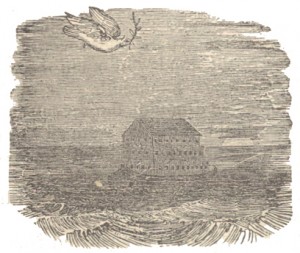 In the six hundredth year of Noah’s life, in the second month, the seventeenth day of the month, the same day were all the fountains of the great deep broken up, and the windows of heaven were opened. (Genesis 7:11)
In the six hundredth year of Noah’s life, in the second month, the seventeenth day of the month, the same day were all the fountains of the great deep broken up, and the windows of heaven were opened. (Genesis 7:11)
Keep in mind that the Biblical calendar of Noah’s day began in the fall. That means the 17th day of the second month would have been the late October early November time frame. It was not until the events of the Exodus that YHWH commanded Israel to begin their calendar relative to the agricultural month of Abib which falls in the spring. As we will see in Part II of this article, YHWH’s command to fix the Israelites’ religious calendar to the month of Abib has some wonderful Messianic implications.
So then, we have historical records which indicate that Halloween, All Saints Day, and the Day of the Dead commemorate the Biblical history of the Deluge, once again proving the Bible is more than a collection of ancient fairy tales as some modern scholars would have you believe.
I started this essay with a quote from George Santayana who said, “Those who cannot remember the past are condemned to repeat it.” The Bible tells us that at the time of the Messiah’s return mankind will have forgotten or no longer care about the past.
And as it was in the days of Noe [Noah], so shall it be also in the days of the Son of man. They did eat, they drank, they married wives, they were given in marriage, until the day that Noe entered into the ark, and the flood came, and destroyed them all. (Luke 17:26-27)
My hope, in sharing this bit of history with you, is that this year on Halloween you’ll remember the past so you aren’t condemned to repeat it. Remember that this day marked the judgment of a righteous God on a sinful world and the greatest loss of human life in the history of mankind. Also, remember the Bible tells us that when the Messiah returns it will be like it was in the days of Noah.
Will we be like Noah and his family who heeded the warning and was protected from YHWH’s righteous judgment? Or will we be like those outside the ark who were blinded by their own sin and didn’t see the judgment coming until it was too late?
And that, knowing the time, that now it is high time to awake out of sleep: for now is our salvation nearer than when we believed. The night is far spent, the day is at hand: let us therefore cast off the works of darkness, and let us put on the armour of light. Let us walk honestly, as in the day; not in rioting and drunkenness, not in chambering and wantonness, not in strife and envying. But put ye on the Lord Jesus Christ, and make not provision for the flesh, to fulfil the lusts thereof. (Romans 13:11-14 )
* * *
The Flood and the Coming Messiah
But there is more to the story. We’ve only touched upon one aspect of the Biblical history of these events. In Part II – The Flood and the Messiah we will look at the deeper implications of the Flood event and the Biblical calendar as it relates to the coming of the Messiah. Join me next time as we explore the context of Israel, Egypt, the Biblical calendar and the greatest Messianic prophecy in the Bible.
* * *
1The Great Pyramid: It’s Divine Message, (Pyramid Records) D. Davidson and C. Aldersmith 1924, pp. 23-26
2Detailed explanations are given in descriptions of Plates IX, X, and XI.
3For the data concerning this refer Section II, ^ 56.
4Breasted, “ Ancient Records,” I, pp. 260-271.
5Frazer, “Adonis, Osiris, Attis,” pp. 241-242.
6” Adonis, Osiris, Attis,” pp. 241-2.
7Ibid., pp. 241-2.
8Ibid.,-pp. 244-8.
9Ibid., pp. 254-5.
10A. Moret, “ Kings and Gods of Egypt,” pp. 69-108, 148-198.
11” Adonis, Osiris, Attis,” p.5 Both are standard works on this subject.
12Abydos II, pp. to, 30, 48.
13In Prof. C. P. Smyth’s “ Life and Work at the Great Pyramid,” Vol. II, p. 390.
14“Refer Section II, H 55.
15“Plutarch, De Iside et Osiride, Vol. FI, p. 336.
16Translation by Dr. Alen H. Gardiner, “ Journal of Egyptian Archaeology,1’ Vol. I, p. 34.
17Translation by Dr. Ed. Naville, “Records of the Past,” 1st series. Vol. VI, pp. 105-112
18Haliburton in Smyth’s “ Life and Work at the Great Pyramid,” Vol. II, pp. 384-386.
19lbid., p. 390.
20”Gods of the Egyptians,” Vol. I, pp. 428-429.
21ll Hallow’s Eve or Hallowe’en ?
Legends of the Phoenix
A Basis in Biblical History
The bird proudly willing to burn,
So that he may live again,
Chooses the flames of fires
That burn the aged Phoenix
The nature stands still
Till a new young bird starts again,
and begins the legend of the Phoenix.
– Claudian
It’s fascinating to me that most ancient cultures have their Legends of the Phoenix. A common theme of these traditions is the death and renewal of this mythical bird after a certain number of years. In what is believed to be one of the oldest Indo-European language texts, the Rig Veda, it calls this mythical bird the Vena. Ancient Egypt associated this legend with the Bennu bird and the Palm tree. Modern Greek tradition calls this bird the Phoenix. While each of these culture’s legends has a common theme they vary widely as to the number of years they claim for the renewal of the Phoenix. So much so it led the 17th century German scholar, George Caspard Kirchmayer, to write the following:
“This creature is quite a myth, and has never been seen except in pictures (I used the words of Herodotus). No man has ever seen it in true reality. Except a “ ‘tis said,” “ ‘tis reported,” “ ‘tis a tale,” or “so they say,” no one can bring forward a clear statement in regard to the matter. I regard as impossible, absurd, and openly ridiculous whatever, except in the way of a fiction, has been told of this creature. Such a belief as that in the phoenix is a slander against Holy Writ, nature, and sound reason. Faced with such a hostile world, the Western phoenix withdrew to the land of fable.“
Is the legend of the Phoenix a myth? Or is it, as it is with many traditions, a legend built in part upon the ashes of some ancient historical truth? Perhaps we might find clues to the identity of the Phoenix in the details of some of these ancient traditions.
Jewish Legends of the Phoenix
Jewish tradition from the Bereshit Rabbah (19:5) states the following concerning their legend of the Phoenix:
“[Eve] gave the cattle, beasts, and birds to eat of it [i.e. the forbidden fruit from the tree of knowledge]. All obeyed her and ate thereof, except a certain bird named chol, as it is written, “Then I said: I shall die with my nest, and I shall multiply my days as the chol .”
Rabbi Shelomo Yitzhaki, or Rashi as he was commonly called, had this to say concerning the Phoenix:
“It is a bird whose name is chol, and death has no power on it, because it did not taste the fruit from the tree of knowledge. At the end of thousand years it renews itself, and returns to his youth.”
Rabbinic tradition believed the Phoenix or “chol” is what was referenced in Job 29:18-19 were it states the following:
Then I said, I shall die in my nest, and I shall multiply my days as the sand {chol}. My root was spread out by the waters, and the dew lay all night upon my branch. (Job 29:18-19)
The English word “sand” in verse 18 is the Hebrew word “chol”. This association of the Phoenix with “chol” is further confirmed by the LXE and TNK translations of Job 29:18-19: Notice in the verses below the association of the Phoenix with Palm Tree as in ancient Egypt.
And I said, My age shall continue as the stem of a palm-tree; I shall live a long while. My root was spread out by the water, and the dew would lodge on my crop. My glory was fresh in me, and by bow prospered in his hand. (LXE Job 29:18-20)
I thought I would end my days with my family, And be as long-lived as the phoenix, My roots reaching water, And dew lying on my branches; (TNK Job 29:18-19 18)
It seems the Jewish legend of the Phoenix involves a mythical bird the Chol. This bird because it did not partake of the forbidden fruit was “taken” to heaven to live for a 1000 years.
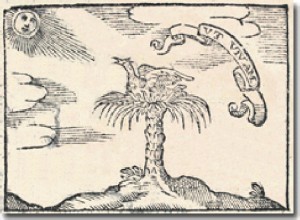 Greek Legends of the Phoenix
Greek Legends of the Phoenix
The modern usage of the term Phoenix comes from the Greek association with the Date Palm. In ancient Egypt the Bennu bird and the Date Palm were given the same name and in many cases were considered synonymous. Some historians speculate the Greeks associated the purple color of the murex shellfish, made famous by the Phoenicians, with the similar purple color of the Date Palm fruit. Hence they believe the term Phoenix was applied to the Bennu bird / Date Palm idea of renewal found in ancient Egyptian traditions. This association was understood in later Medieval thought as shown by Juan de Horozco’s Sacra symbola (Agrigento 1601)(on the right). In this Latin book of emblems he shows the Phoenix nesting in the Palm tree. As already mentioned this same idea is found in various translations of Job 29:18-19 were the Palm Tree and the Phoenix were used interchangeably.
According to many accounts of the Greek legend, the Phoenix was reborn or renewed after 500 years (Herodotus, Ovid, Mandeville). Pliny gives 540 years. The historian, Tacitus, in his Annals (VI 29), give both 500 years and 1461 years as the lengths of the Phoenix cycle. In addition the Jewish traditions, Martial, Claudian, Lactantius and Nonno ascribe 1000 years to the Phoenix cycle. Stuart Pool argued the cycle was 1460 years. It was his opinion the Phoenix cycle was synonymous with the Egyptian Sothic cycle.
Chinese, Indian and Native American Legends of the Phoenix
In China, the legend centers around Fung or Geng-Huang. This mythical bird comes to earth to help in the development of mankind and then returns to heaven. In India the bird was called the Vena and the native Americans called it the Thunderbird.
Egyptian Legends of the Phoenix
Most traditions concerning the Phoenix appear to originate in the legends of ancient Egypt. It was in Egypt were the Bennu bird (a heron or stork like bird) and the Palm tree are first associated with the Phoenix legend. Interestingly a Palm tree or Palm shoot is the hieroglyph symbol used for the 365 day year in ancient Egypt.
Palm – Hieroglyph
the symbol used for the year in ancient Egypt
Horapollinis in his Hieroglyphica (1595) states the following concerning the year:
When they would represent a year, they delineate Isis, i.e,. a woman. …………………… When they would represent the year otherwise, they delineate a Palm Tree [branch], because of all others this tree alone at each renovation of the moon produces one additional branch, so that in twelve branches the year is completed.
On the surface it does not appear obvious why the Egyptians associated the Bennu bird and the Palm Tree with the Phoenix. We know both Jewish and Greek thought realized this association but they do not give a reason for it. The symbolism of a bird’s renewal or rebirth and flight into heaven is a common theme regardless of the tradition. But where does the Palm Tree fit into this symbolism? It is obvious from the Latin name for the Palm Tree (Phoenix dactylifera) that there is some relationship between the Palm Tree and the Phoenix idea. What is the relationship?
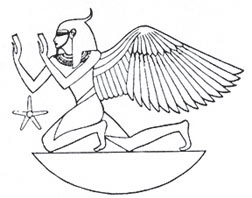 We know from Egyptian and Greek thought the Palm tree was representative of the year cycle of 365 or 365.25 days. It appears the ancient Egyptian traditions concerning the Phoenix cycle and its associated legends though have origins in a much earlier civilization. A careful investigation of the chronology of ancient Egypt shows the Phoenix cycle was associated with their dynastic calculations. Whatever the root of the Phoenix legend it has had a profound impact on the collective consciousness of those ancient chronologists.
We know from Egyptian and Greek thought the Palm tree was representative of the year cycle of 365 or 365.25 days. It appears the ancient Egyptian traditions concerning the Phoenix cycle and its associated legends though have origins in a much earlier civilization. A careful investigation of the chronology of ancient Egypt shows the Phoenix cycle was associated with their dynastic calculations. Whatever the root of the Phoenix legend it has had a profound impact on the collective consciousness of those ancient chronologists.
Biblical Legends of the Phoenix
Even those who do not share my believe that the Bible is an inspired text may appreciate the Biblical version of the Phoenix legend. In fact, it is the Biblical narrative which provides the key to understanding the various legends associated with the Phoenix.
By faith Enoch was translated that he should not see death; and was not found, because God had translated him: for before his translation he had this testimony, that he pleased God. (Hebrews 11:5)
And all the days of Enoch were three hundred sixty and five years: And Enoch walked with God: and he was not; for God took him. (Genesis 5:23-24)
In ancient Egypt the Pa prefix to a proper name designates the “father of the house of” or “the house of” that person. Phoenix or Ph – Oenix (Pa-Hanok) is the Grecianised form of the Egyptian title for the “house of” Hanok or Enoch. The Legend of the Phoenix is nothing more than the ancient traditions concerning the life of Biblical hero Enoch.
According to the Biblical narrative Enoch was taken to Heaven after 365 years. In ancient Egypt this was considered a “great year”. Hence the Date Palm tree (Phoenix dactylifera) hieroglyphic was used to represent the year. This might also explain the Jewish and Egyptian traditions concerning the Phoenix and the Palm tree as mentioned above. According to the Biblical narrative, Enoch in his 365th year, “walked with God” and he was taken heaven. According to Hebrews 11:5 Enoch was “translated” because he pleased God. According to Biblical chronology it was the 987th year from Adam (almost 1000 yrs.) when this translation of Enoch (Phoenix) occurred. This 987th year (rounded) may be the basis for the legend of the 1000 year phoenix cycle.
Herodotus:
“They have also another sacred bird called the phoenix which I myself have never seen, except in pictures. Indeed it is a great rarity, even in Egypt, only coming there (according to the accounts of the people of Heliopolis) once in five hundred years, when the old phoenix dies. Its sixe and appearance, if it is like the pictures, are as follows: The plumage is partly red, partly golden, while the general make and size are almost exactly that of the eagle. They tell a story of what this bird does, which does not seem to me to be credible, that he comes all the way from Arabia, and brings the parent bird, all plastered over with myrrh, to the temple of the Sun, and there buries the body. In order to bring him, they say, he first forms a ball of myrrh as big as he finds that he can carry; then he hollows out the ball, and puts his parent inside, after which he covers over the opening with fresh myrrh, and the ball is then of exactly the same weight as at first; so he brings it to Egypt, plastered over as I have said, and deposits it in the temple of the Sun. Such is the story they tell of the doings of this bird.”
Many of the other traditions for the length of the phoenix cycle can be shown to have some relationship to the chronology of the life of Enoch. Some cycles are relative to Enoch’s age of 365 years at his ascension into heaven. Others are relative to the 987 years from Adam to Enoch’s ascension. A few examples are adequate to illustrate the point. Both 1460 and 1461 years have been claimed by some to represent the Phoenix cycle. 1460 and 1461 are 4×365 and 4×365.25 years respectively. Both are 4 cycles of Enoch’s life. The 500 years of the Greeks is half the earlier traditions of the 1000 years of the Hebrews and Egyptians. In ancient Egypt one of the most important cycles is their dynastic chronology is the 329 year cycle. This 329 years cycle is 1/3 of the 987 years the Bibles gives from Adam to Enoch. This cycle is likely the original lost Phoenix cycle of the ancient Egyptians.
It seems the ancient traditions of the Phoenix legend, regardless of their origin, have a common root in the Biblical narrative of Enoch. The various legendary cycles of the House of Enoch (Pa Enoch or Phoenix) can be shown to have a common root in dynastic chronologies of Genesis. A case can also be made that the ancient Egyptians likely inherited much of their cyclical traditions from this earlier civilization. The Biblical chronology from Adam to Noah shows they were aware or possibly originated the ancient cycles of Sed festival, the Sep Tep Sed festival, the 103 year intercalary cycle, the 329 year (Phoenix) cycle, the 1460 Year Sothic cycle, and 365 “great year” cycle. Each of these cycles figures prominently in the Biblical chronology. Many of them are associated with Legend of the Phoenix or as we now know the traditions surrounding the Biblical hero Enoch.
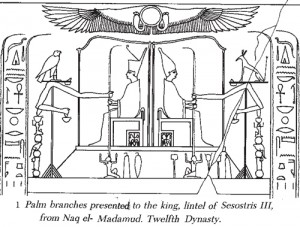 Mandeville – “In Egypt is the city of Heliopolis, that is to say, the city of the Sun. In that city there is a temple, made round after the shape of the Temple of Jerusalem. The priests of that temple have all their writings, under the date of the fowl that is clept phoenix; and there is none but one in all the world. And he cometh to burn himself upon the altar of that temple at the end of five hundred year; for so long he liveth. And at the five hundred years’ end, the priests array their altar honestly, and put thereupon spices and sulphur and other things that will burn lightly; and then the bird phoenix cometh and burneth himself to ashes. And the first day next after, men find in the ashes a worm; and the second day next after, men find a bird quick and perfect; and the third day next after, he flieth his way. And so there is no more birds of that kind in all the world, but it alone, and truly that is a great miracle of God. And men may well liken that bird unto God, because that there is no God but one; and also, that our Lord arose from death to life the third day. This bird men see often-time fly in those countries; and he is not mickle more than an eagle. And he hath a crest of feathers upon his head more great than the peacock hath; and is neck his yellow after color of an oriel that is a stone well shining, and his beak is colored blue as ind; and his wings be of purple color, and his tail is barred overthwart with green and yellow and red. And he is a full fair bird to look upon, against the sun, for he shineth full gloriously and nobly.”
Mandeville – “In Egypt is the city of Heliopolis, that is to say, the city of the Sun. In that city there is a temple, made round after the shape of the Temple of Jerusalem. The priests of that temple have all their writings, under the date of the fowl that is clept phoenix; and there is none but one in all the world. And he cometh to burn himself upon the altar of that temple at the end of five hundred year; for so long he liveth. And at the five hundred years’ end, the priests array their altar honestly, and put thereupon spices and sulphur and other things that will burn lightly; and then the bird phoenix cometh and burneth himself to ashes. And the first day next after, men find in the ashes a worm; and the second day next after, men find a bird quick and perfect; and the third day next after, he flieth his way. And so there is no more birds of that kind in all the world, but it alone, and truly that is a great miracle of God. And men may well liken that bird unto God, because that there is no God but one; and also, that our Lord arose from death to life the third day. This bird men see often-time fly in those countries; and he is not mickle more than an eagle. And he hath a crest of feathers upon his head more great than the peacock hath; and is neck his yellow after color of an oriel that is a stone well shining, and his beak is colored blue as ind; and his wings be of purple color, and his tail is barred overthwart with green and yellow and red. And he is a full fair bird to look upon, against the sun, for he shineth full gloriously and nobly.”
Please note that credit for many of the ideas for this essay must be given to D. Davidson. and C. Aldersmith. It was from their Pyramid Records in The Great Pyramid: It’s Divine Message that I first read about the association between Enoch and the legends of the phoenix.
The 14th Sacrifice
Authors Note:
Based upon the Bible’s calendar today is the 14th day of the 1st month. Nearly 2000 years ago about this time Yeshua of Nazareth became “the lamb of God which taketh away the sins of the world”. Later today many of us will celebrate Passover in rememberance of Yeshua’s sacrifice on our behalf. With this in mind I thought it appropriate to share some little known symbolism associated with this wonderfully symbolic Biblical holyday. The following is taken from my book The 13th Enumeration: Key to the Bible’s Messianic symbolism.
The 14th Sacrifice
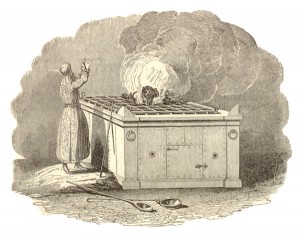 Yet it pleased YHWH to bruise him; he hath put him to grief: when thou shalt make his soul an offering for sin, he shall see his seed, he shall prolong his days, and the pleasure of YHWH shall prosper in his hand. He shall see of the travail of his soul, and shall be satisfied: by his knowledge shall my righteous servant justify many; for he shall bear their iniquities. Therefore will I divide him a portion with the great, and he shall divide the spoil with the strong; because he hath poured out his soul unto death: and he was numbered with the transgressors; and he bare the sin of many, and made intercession for the transgressors.—Isaiah 53:10–12
Yet it pleased YHWH to bruise him; he hath put him to grief: when thou shalt make his soul an offering for sin, he shall see his seed, he shall prolong his days, and the pleasure of YHWH shall prosper in his hand. He shall see of the travail of his soul, and shall be satisfied: by his knowledge shall my righteous servant justify many; for he shall bear their iniquities. Therefore will I divide him a portion with the great, and he shall divide the spoil with the strong; because he hath poured out his soul unto death: and he was numbered with the transgressors; and he bare the sin of many, and made intercession for the transgressors.—Isaiah 53:10–12
I’m continually thrilled by the Messianic symbolism YHWH has hidden in the Scripture for us to find. To me, it’s the ultimate treasure hunt, with each new find bringing additional depth and beauty to our Creator’s plan of reconciliation for all mankind through Yeshua.
Purge out therefore the old leaven, that ye may be a new lump, as ye are unleavened. For even Christ our passover is sacrificed for us: therefore let us keep the feast, not with old leaven, neither with the leaven of malice and wickedness; but with the unleavened bread of sincerity and truth. (1 Corinthians 5:7–8)
It was therefore necessary that the patterns of things in the heavens should be purified with these; but the heavenly things themselves with better sacrifices than these . . . So Christ was once offered to bear the sins of many; and unto them that look for him shall he appear the second time without sin unto salvation. (Hebrews 9:23–28)
For the law having a shadow of good things to come, and not the very image of the things, can never with those sacrifices which they offered year by year continually make the comers thereunto perfect . . . we are sanctified through the offering of the body of Jesus Christ once for all. (Hebrews 10:1–10)
A Wonderful Puzzle
Right up front, I’ll admit my bias: I believe the Bible to be the inspired words of YHWH. When there are passages that don’t make any sense or seem downright funky—passages like Matthew 1—I like to look at these parts as a wonderful puzzle to solve.
Another good example of what I’m talking about is the order and number of sacrifices prescribed during the biblical feast days. I mean, have you ever looked at the numbers of the sacrifices YHWH commanded Israel to offer? For instance, why were two bullocks, one ram, and seven lambs required to be offered during the Feast of Unleavened Bread? Doesn’t that seem just a little unusual to you? Their number and order are obviously specific—but why?
For those who have looked, you would have to say it is almost like a code. If there is a symbolic or coded message in the number of sacrifices prescribed in the Old Testament, could it somehow be related to the Messianic symbolism we have already found in the biblical holy days—or to Matthew 1? What are the chances the 13th Enumeration could be the key? Let’s take a look and see.
What better place to start than the book of the Bible the Jewish people call Bemidbar, “in the desert”—probably better known to you and me as the book of Numbers. The fourth book of the Bible, Numbers gives more details about the biblical sacrifices prescribed during the feast days than any other place in the Scriptures.
The first biblical feast day begins in the spring, with Passover, on the 14th day of the first month at “even.” In biblical timekeeping, evening, or sundown, begins the day. In this case, the evening of the 14th is the start of the 15th day of Nisan. Fourteen days earlier, the Torah honors the start of the biblical calendar with the following instructions:
And in the beginnings of your months ye shall offer a burnt offering unto YHWH; two young bullocks, and one ram, seven lambs of the first year without spot . . . and one kid of the goats for a sin offering unto YHWH shall be offered, beside the continual burnt offering, and his drink offering. (Numbers 28:11–15)
You know, I still ask myself how I missed it all these years:
2 bullocks (burnt offering)
1 ram (burnt offering)
7 lambs (burnt offering)
1 kid of the goats (sin offering)
2 lambs (continual burnt offering)
13 total sacrifices
Right there in the book of Numbers, the biblical calendar begins with 13 sacrifices. How awesome is that!
And walk in love, as Christ also hath loved us, and hath given himself for us an offering and a sacrifice to God for a sweetsmelling savour. (Ephesians 5:2)
But the symbolism doesn’t stop there. Numbers 28 and 29 go on to prescribe 13 sacrifices each day for the entire Feast of Unleavened Bread, as well as during Shavuot, Yom Kippur, and the 8th day of Tabernacles.[1] As we will see in the next chapter, the sacrificial instructions for the first seven days of the Feast of Tabernacles (Sukkoth) are nothing short of amazing!
But before we get to that, there is a hidden treasure yet to be discovered in the Feast of Unleavened Bread. Unleavened Bread is a feast of seven days which began with the Passover supper. In order to see the wonderful symbolism here, a little history of Israel’s exodus from Egypt is required.
Few Old Testament stories capture our imaginations like the exodus of Israel from Egypt. From Moses’s confrontation with Pharaoh to the plagues, the angel of death, and finally the crossing of the Red Sea, the imagery is captivating, sobering, and finally triumphant. The events described in the book of Exodus set a pattern or shadow, if you will, which the New Testament sees fulfilled in the death and resurrection of Yeshua.
Most of us know the story of the Passover. Every Israelite household was instructed to kill a lamb and mark the doorposts with its blood. This sacrifice is described in the Bible as “YHWH’s Passover.” The angel of death would “pass over” any house upon which this blood was found, thus sparing the inhabitants the death of their firstborn in Egypt’s most terrible plague.
The order and timing of these events are fascinating, not the least because they mark the Passover with the symbolism of the numbers 13 and 14. Let’s take a look:
And they departed from Rameses in the first month, on the fifteenth day of the first month; on the morrow after the passover the children of Israel went out with an high hand in the sight of all the Egyptians. For the Egyptians buried all their firstborn, which YHWH had smitten among them: upon their gods also YHWH executed judgments. (Numbers 33:3 4)
The above passage gives us an excellent fixing point in the chronology of the exodus. Verse 3 makes it clear that the exodus from Egypt began on the 15th day of the first month. Further, it informs us that this same day, the Egyptians were busy burying their firstborn dead. Exodus 12 fixes the chronology even further with the instructions concerning the Passover lamb. They were to keep this lamb until the 14th day, kill it in the evening (sundown) of the 14th day, and then eat it that night, which began the 15th of Nisan—the same night the angel of death passed over Egypt.
Your lamb shall be without blemish, a male of the first year . . . And ye shall keep it up until the fourteenth day of the same month: and the whole assembly of the congregation of Israel shall kill it in the evening. And they shall take of the blood, and strike it on the two side posts and on the upper door post of the houses, wherein they shall eat it. And they shall eat the flesh in that night, roast with fire, and unleavened bread; and with bitter herbs they shall eat it. Eat not of it raw, nor sodden at all with water, but roast with fire; his head with his legs, and with the purtenance thereof . . . And ye shall let nothing of it remain until the morning; and that which remaineth of it until the morning ye shall burn with fire.
And thus shall ye eat it; with your loins girded, your shoes on your feet, and your staff in your hand; and ye shall eat it in haste: it is YHWH’S passover. For I will pass through the land of Egypt this night, and will smite all the firstborn in the land of Egypt, both man and beast; and against all the gods of Egypt I will execute judgment: I am YHWH. (Exodus 12:5–12)
And it came to pass, that at midnight YHWH smote all the firstborn in the land of Egypt . . . And Pharaoh rose up in the night, he, and all his servants, and all the Egyptians; and there was a great cry in Egypt; for there was not a house where there was not one dead. And he called for Moses and Aaron by night, and said, Rise up, and get you forth from among my people . . . And the Egyptians were urgent upon the people, that they might send them out of the land in haste; for they said, We be all dead men. (Exodus 12:29–33)
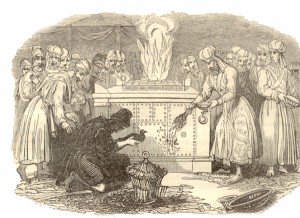 Based upon the above chronology, the Passover lambs were killed on the 14th of Nisan just before or right at sundown, which began the 15th day of the month. This passage makes it clear that the sacrifice was not eaten until that “night,” the very same night the angel of death “passed over” the land of Egypt. Remember, a new biblical day begins at sundown.
Based upon the above chronology, the Passover lambs were killed on the 14th of Nisan just before or right at sundown, which began the 15th day of the month. This passage makes it clear that the sacrifice was not eaten until that “night,” the very same night the angel of death “passed over” the land of Egypt. Remember, a new biblical day begins at sundown.
And God called the light Day, and the darkness he called Night. And the evening and the morning were the first day. (Genesis 1:5)
Now consider once again the instructions of Numbers 28 in light of this chronology. Numbers 28 requires 13 sacrifices to be made on the 15th of Nisan, the first day of the Feast of Unleavened Bread. But there is a 14th sacrifice as well. The Passover lamb, killed on the 14th, was to be eaten “in that night,” which began the 15th of Nisan. So in fitting symbolism, just as Matthew 1 showed Yeshua as both the 13th and 14th Enumerations, the first day of the Feast of Unleavened Bread, the very biblical holyday which represents Yeshua’s atonement on our behalf, requires 13 sacrifices to be made, but in fact 14 are consumed! This brings new meaning to the words of Paul in his epistle to the Corinthians:
Purge out therefore the old leaven, that ye may be a new lump, as ye are unleavened. For even Christ our passover is sacrificed for us. (1 Corinthians 5:7)
For more on Yeshua’s Passover Week chronology please see the following articles:
* The 14th Sacrifice
* “The Feast Day”: Judas’ Betrayal
* Defiled on the “Passover”
* The “Preparation” Day
* The “3rd Day”
* “The Sign of Jonah
And thou shalt say unto them, This is the offering made by fire which ye shall offer unto YHWH; two lambs of the first year without spot day by day, for a continual burnt offering. —Numbers 28:3–4
“and in the fourteenth day of the first month is the passover of YHWH. And in the fifteenth day of this month is the feast: seven days shall unleavened bread be eaten . . . But ye shall offer a sacrifice made by fire for a burnt offering unto YHWH; two young bullocks, and one ram, and seven lambs of the first year . . . and one goat for a sin offering, to make an atonement for you. Ye shall offer these beside the burnt offering in the morning, which is for a continual burnt offering. After this manner ye shall offer daily, throughout the seven days, the meat of the sacrifice made by fire, of a sweet savour unto YHWH: it shall be offered beside the continual burnt offering, and his drink offering. —Numbers 28:16–24
Also in the day of the firstfruits . . . But ye shall offer the burnt offering for a sweet savour unto YHWH; two young bullocks, one ram, seven lambs of the first year . . . and one kid of the goats, to make an atonement for you. Ye shall offer them beside the continual burnt offering, and his meat offering, (they shall be unto you without blemish) and their drink offerings. —Numbers 28:26–31
[1] The Feast of Trumpets, according to Numbers 29, also requires 13 sacrifices, but if the new-moon sacrifices of the first month are included, they make for 24. Leviticus 23 includes two peace offerings for the feast of Shavuot that are not included in the sacrifices of Numbers 28. This would make for 15 if both instructions were combined. It is also important to note that any day that fell on a Sabbath required two additional sacrifices.
Nowruz (new light) on 13
Author’s Note: With the Persian new year (Nowruz) beginning in a few days I thought it appropriate to share a little bit of Persian and Jewish history related to the subject. The following is taken from my new book: The 13th Enumeration: Key to the Bible’s Messianic Symbolism.
Of Superstitions, Heroines, and April Fools
“Then Paul stood in the midst of Mars’ hill, and said, Ye men of Athens, I perceive that in all things ye are too superstitious. For as I passed by, and beheld your devotions, I found an altar with this inscription, TO THE UNKNOWN GOD. Whom therefore ye ignorantly worship, him declare I unto you.”—Acts 17:22–23
Any investigation of the number 13 in biblical or secular history would be incomplete without looking at the superstitions surrounding it. We’re all familiar with the fear and “bad luck” associated with this number around the world. What’s the deal? Why 13? With all the biblical symbolism pointing to the Messiah, what makes this number so infamous?
By now you’ve probably realized that it would be to our adversary’s advantage for the world to associate the number 13 with evil in some way. I mean, what better way for Satan to cover up a great biblical truth than to hide it in plain sight beneath a superstition? But what about the superstition—does it have any basis in historical fact?
Every really good deception has a kernel of truth. Let’s look and see if we can find the truth behind the ill omens and bad luck surrounding the number 13. I think the history may surprise you.
Back in Time
Let’s go back in history to one of the first associations between the number 13 and bad luck. Back before Mary Kay become engrossed with the number 13; before Napoleon Bonaparte, J. Paul Getty, Herbert Hoover, and Franklin Delano Roosevelt became superstitious; before 13 became associated with American Masonic lore; before Jacques de Molay was murdered on Friday the 13th; before the Knights Templar; before Yeshua and His 12 apostles—back five hundred years to a biblical story of revenge, betrayal, heroism, and the number 13.
Casting Pur
This is the story of a young Jewish woman who risked her own life to save her people from certain destruction, a story that began in the first month of the twelfth year of the Persian King Ahasuerus, when a villain named Haman started casting pur (lots) to find a good day to kill all the Jews in the kingdom of Persia. Twelve months later, Haman approached King Ahasuerus with a story that a certain people group in his kingdom were subversives. If it pleased the king, Haman would solve the Jewish problem in the kingdom of Persia once and for all.
In the first month, that is, the month Nisan, in the twelfth year of king Ahasuerus, they cast Pur, that is, the lot, before Haman from day to day, and from month to month, to the twelfth month, that is, the month Adar. (Esther 3:7)
And the king said unto Haman, The silver is given to thee, the people also, to do with them as it seemeth good to thee. Then were the king’s scribes called on the thirteenth day of the first month, and there was written according to all that Haman had commanded unto the king’s lieutenants, and to the governors that were over every province, and to the rulers of every people of every province according to the writing thereof, and to every people after their language; in the name of king Ahasuerus was it written, and sealed with the king’s ring. (Esther 3:11–12)
King Ahasuerus listened to Haman’s advice, and the following month, in the 13th year of King Ahasuerus’s reign, on the 13th day of the 13th month from when the first lot was cast, Ahasuerus granted Haman permission to destroy the Jewish people. So the decree was sent out and the date of destruction was set for the 13th day of Adar in the 13th year of Ahasuerus.
We know from the biblical account that Hadassah (Esther) intervened, Haman was hanged, and the king issued another decree that allowed the Jewish people to defend themselves from their enemies. So instead of a day of sorrow and loss, the 13th day of Adar became a day of deliverance and joy. But the story doesn’t end there. Hadassah petitioned the king to allow the Jewish people who lived in the Persian capital of Shushan to pursue their enemies on the 14th day as well.
Wherein the king granted the Jews which were in every city to gather themselves together, and to stand for their life, to destroy, to slay, and to cause to perish, all the power of the people and province that would assault them, both little ones and women, and to take the spoil of them for a prey, upon one day in all the provinces of king Ahasuerus, namely, upon the thirteenth day of the twelfth month, which is the month Adar. (Esther 8:11–12)
But the Jews that were at Shushan assembled together on the thirteenth day thereof, and on the fourteenth thereof. (Esther 9:18)
So 2500 years ago, the 13th and 14th days of Adar in the 13th year of a Persian king became one of the most celebrated events in Jewish history. In the festival of Purim, these days commemorate the deliverance of the Jewish people by the hand of YHWH through the efforts of a young Jewish queen of Persia.
On the thirteenth day of the month Adar; and on the fourteenth day of the same rested they, and made it a day of feasting and gladness. But the Jews that were at Shushan assembled together on the thirteenth day thereof, and on the fourteenth thereof; and on the fifteenth day of the same they rested, and made it a day of feasting and gladness. (Esther 9:17–18)
And Now for the Rest of the Story . . .
About the same time this biblical story was unfolding, a Persian tradition records the commemoration of a day of ill omen and bad luck. The Persian New Year celebration of Nowruz, literally “new light,” begins in the spring about the time of the spring equinox. This New Year’s celebration is twelve days long, leading up to the 13th day of the Persian new year. On this day, Persians celebrate Sizdah-bedar, which literally means “getting rid of” or “getting past” 13. You see, they believed that if they could get past the 13th day without anything bad happening, they were home free for the rest of the year. In modern times, Persians celebrate the day by visiting the countryside and playing practical jokes on each other. This has led some to speculate that this day may be the origin of April Fool’s Day.
An April Fool
In stunning irony, Sizdah-bedar was likely the very day upon which King Ahasuerus granted Haman permission to kill all the Jews of Persia. In true April Fool’s fashion, the joke was on Haman. An entire race of people were marked for death on Sizdah-bedar, the day of “getting rid of 13,” due to the hatred of one man—a man we now know as history’s greatest April fool.
So next time April Fool’s Day comes around, give a thought to an ancient Persian superstition regarding the number 13 and how YHWH used a pur to mark this day in infamy. A day meant for the death and destruction of the Jewish people was instead turned into a celebration of deliverance that has been commemorated every year, for the past 2500 years, on the 13th, 14th,, and 15th days of Adar.
The lot is cast into the lap; but the whole disposing thereof is of YHWH. (Proverbs 16:33)
Not Given to the Spirit of Fear
I think there is a lesson to be learned from this little bit of history. As believers, we shouldn’t be afraid of unreasonable fears, superstitions, or unfounded conspiracy theories. As we’ve seen, the ill omens and bad luck surrounding the number 13 are merely a deception or veneer used by Satan to cover up one of the most profound examples of Messianic symbolism found in the Bible.
“For God hath not given us the spirit of fear; but of power, and of love, and of a sound mind.”
—2 Timothy 1:7
The Forgotten Covenant
 You know lately I’ve been especially awed at how congruent the Biblical message is about the promised Messiah. As many of you know I’ve been working on Book II in my Prophecies and Patterns series: Daniel’s 70 Weeks: Keystone of Bible Prophecy. Those with an interest in Bible prophecy are likely familiar with the infamous “covenant” mentioned in the prophecy of 70 Weeks. By far the majority of scholars today believe this covenant found in Daniel 9:27 is made by some yet future evil world leader and it is this covenant that sets in motion the final seven years of this age before the Messiah Yeshua returns to reign on this earth.
You know lately I’ve been especially awed at how congruent the Biblical message is about the promised Messiah. As many of you know I’ve been working on Book II in my Prophecies and Patterns series: Daniel’s 70 Weeks: Keystone of Bible Prophecy. Those with an interest in Bible prophecy are likely familiar with the infamous “covenant” mentioned in the prophecy of 70 Weeks. By far the majority of scholars today believe this covenant found in Daniel 9:27 is made by some yet future evil world leader and it is this covenant that sets in motion the final seven years of this age before the Messiah Yeshua returns to reign on this earth.
But what about the other covenant mentioned in Daniel 9? How many of you are familiar with the covenant of Daniel 9:4? Arguably, it is this covenant which establishes the underlying context for the prophecy which was revealed to Daniel by the angel Gabriel. In fact a careful reading of Daniel 9:1-23 shows that the prophecy of 70 weeks was, in part, an answer to Daniel’s impassioned prayer in those first twenty three verses.
And I prayed unto YHWH my God, and made my confession, and said, O Lord, the great and dreadful God, keeping the covenant and mercy to them that love him, and to them that keep his commandments; Daniel 9:4
To me, one of the most wonderful aspects of the Bible is the consistency of its messianic message. Each part builds color and texture to show our Creator YHWH’s, love for mankind and His plan to reconcile us to Him. To be sure sometimes the threads of this plan are not obvious and other times they are on bold display but you can count on the fact that each thread builds part of the tapestry which shows YHWH’s love.
Here in Daniel 9:4 we have a major thread of YHWH’s plan to reconcile mankind to Himself. Together let’s trace that thread back in time and see if we can find the original context of this forgotten covenant.
Crossing the Jordan
Our first destination takes us back to very end of Israel’s 40 years in the wilderness. Israel is just this side of the Jordan river and ready to enter the Promised Land. Moses is admonishing, instructing, and encouraging the people before he passes leadership to Joshua (Yeshua) the son of Nun and Israel crosses over the Jordan.
37 And because he loved thy fathers, therefore he chose their seed after them, and brought thee out in his sight with his mighty power out of Egypt; (Deuteronomy 4:37)
6 For thou art an holy people unto YHWH thy God: YHWH thy God hath chosen thee to be a special people unto himself, above all people that are upon the face of the earth. 7 YHWH did not set his love upon you, nor choose you, because ye were more in number than any people; for ye were the fewest of all people:
8 But because YHWH loved you, and because he would keep the oath which he had sworn unto your fathers, hath YHWH brought you out with a mighty hand, and redeemed you out of the house of bondmen, from the hand of Pharaoh king of Egypt. 9 Know therefore that YHWH thy God, he is God, the faithful God, which keepeth covenant and mercy with them that love him and keep his commandments to a thousand generations;…. 12 Wherefore it shall come to pass, if ye hearken to these judgments, and keep, and do them, that YHWH thy God shall keep unto thee the covenant and the mercy which he sware unto thy fathers: (Deuteronomy 4:34; 7:6-12)
Covenant and MercyJust to be clear that the Daniel is referring to the same “covenant and mercy” as mentioned by Moses in Deuteronomy, all we need to do is read the next several verses of Daniel 9. Daniel goes on to acknowledge that indeed they had not kept the words of Moses and he pleads with YHWH despite that, to remember the Exodus and His deliverance of them from Egypt.
Consider the context of Daniel’s words in chapter 9 for a moment. Here we find Daniel a very old man who has been a captive in the land of Babylon for nearly 70 years. He has just read and understood the prophecy of Jeremiah in which he learns that his captivity is nearly over. For further clarity remember that it was Daniel’s captivity along with king Jehoiakim which began the 70 years prophesied by Jeremiah. (Daniel 1:1-6)
Promised to the Fathers
With this realization Daniel gives one of the most beautiful and impassioned prayers in the Bible. This prayer is the catalyst for the prophecy of 70 Weeks which followed. In this context the very first words out of Daniel’s mouth concerning the “covenant and mercy” take on added significance.
So what is the “covenant and mercy” promised to the fathers and when did this covenant take effect? According to Moses in Deuteronomy 9:5 the “fathers” are none other than Abraham, Isaac, and Jacob. Keep in mind the passage below is still within the context of Moses’ speech to Israel before they were to cross over the Jordan river and take possession of the Promised Land.
5 Not for thy righteousness, or for the uprightness of thine heart, dost thou go to possess their land: but for the wickedness of these nations YHWH thy God doth drive them out from before thee, and that he may perform the word which YHWH sware unto thy fathers, Abraham, Isaac, and Jacob.(Deuteronomy 9:5)
So there you have it. The covenant and mercy promised to the fathers which Moses mentioned in Deut. 7, begins with the father Abraham. So let’s explore this covenant made with Abraham and see why Daniel might bring this to mind when he petitioned YHWH in Daniel 9:4.
The Faith of Abraham
To me one of the most poignant stories in the Bible is when YHWH tests Abraham’s faith by asking him to sacrifice his only son. Abraham’s response and actions are a testimony to his amazing faith. It is here in the 22nd chapter of Genesis where we find this story and the origins of the “covenant” which both Moses and Daniel mention. Take a moment to read a few excerpts of this wonderful story.
And it came to pass after these things, that God did tempt Abraham, and said unto him, Abraham: and he said, Behold, here I am. 2 And he said, Take now thy son, thine only son Isaac, whom thou lovest, and get thee into the land of Moriah; and offer him there for a burnt offering upon one of the mountains which I will tell thee of. (Genesis 22:1-2)
So Abraham arrives in the land of Moriah where he knew he was to sacrifice his son on one of the mountains, but listen to his faith speaking in this passage:
5 And Abraham said unto his young men, Abide ye here with the ass; and I and the lad will go yonder and worship, and come again to you. (Genesis 22:5)
The next passage is one of my favorites. Listen to words of a father and his young son. These words are both a testimony to Abraham’s faith but also a prophecy which speaks to the coming Messiah:
7 And Isaac spake unto Abraham his father, and said, My father: and he said, Here am I, my son. And he said, Behold the fire and the wood: but where is the lamb for a burnt offering? 8 And Abraham said, My son, God will provide himself a lamb for a burnt offering: so they went both of them together. (Genesis 22:7-8)
As a father of five precious children this passage nearly brings me to tears when I read it. How innocent Isaac’s question and what faith by Abraham. I can’t help but ask myself if I would have that kind of faith. Thankfully Abraham had that faith because as you will see it was this act of faith which YHWH used to bring forth the “seed” of the Messiah.
15 And the angel of YHWH called unto Abraham out of heaven the second time, 16 And said, By myself have I sworn, saith the YHWH, for because thou hast done this thing, and hast not withheld thy son, thine only son: 17 That in blessing I will bless thee, and in multiplying I will multiply thy seed as the stars of the heaven, and as the sand which is upon the sea shore; and thy seed shall possess the gate of his enemies; 18 And in thy seed shall all the nations of the earth be blessed; because thou hast obeyed my voice. (Genesis 22:15-18) You see the covenant made with Abraham was not just about Israel and their possession of the Promised Land but it was covenant which promised that through Abraham all nations of the earth would be blessed. The apostle Paul explains this passage more fully in Galatians 3.16 Now to Abraham and his seed were the promises made. He saith not, And to seeds, as of many; but as of one, And to thy seed, which is Christ. 17 And this I say, that the covenant, that was confirmed before of God in Christ, the law, which was four hundred and thirty years after, cannot disannul, that it should make the promise of none effect.(Galatians 3:16-17)
In beautiful Biblical congruency this passage by the apostle Paul brings us full circle. The forgotten covenant mentioned by the prophet Daniel in Daniel 9:4 is none other than the promise of the coming Messiah by which all nations of the earth were to be blessed. How awesome and appropriate is that! Daniel’s first words in chapter 9 are a petition to the living God of the Bible to remember the covenant of the coming Messiah. In answer to Daniel’s prayer, just twenty verses later, YHWH sends the angel Gabriel with the prophecy of 70 weeks, the defining Messianic prophecy in the Scripture.
23 At the beginning of thy supplications the commandment came forth, and I am come to shew thee; for thou art greatly beloved: therefore understand the matter, and consider the vision. 24 Seventy weeks are determined upon thy people and upon thy holy city, to finish the transgression, and to make an end of sins, and to make reconciliation for iniquity, and to bring in everlasting righteousness, and to seal up the vision and prophecy, and to anoint the most Holy. (Daniel 9:23-24)
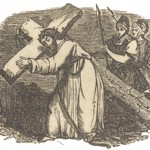 A Wonderful Plan of Redemption
A Wonderful Plan of Redemption
As I stated at the beginning of this article, the Bible is congruent. YHWH has had a plan to reconcile mankind through Yeshua, the promised “seed” of Abraham and this plan of redemption is woven into every aspect of the Biblical record. This promised reconciliation is the very essence of the prophecy of Daniel’s 70 Weeks from the start of Daniel’s prayer to the very last verse.
So next time you are thinking about the “covenant” of Daniel 9:27 won’t you considered the forgotten covenant of Daniel 9:4? While you are at it consider it in light of the words of Zechariah, the father of John, and Mary, the mother of Yeshua.
68 Blessed be the Lord God of Israel; for he hath visited and redeemed his people, 69 And hath raised up an horn of salvation for us in the house of his servant David; 70 As he spake by the mouth of his holy prophets, which have been since the world began:… 72 To perform the mercy promised to our fathers, and to remember his holy covenant; 73 The oath which he sware to our father Abraham,… To give knowledge of salvation unto his people by the remission of their sins, 78 Through the tender mercy of our God; whereby the dayspring from on high hath visited us, 79 To give light to them that sit in darkness and in the shadow of death, to guide our feet into the way of peace. (Luke 1:68-79 – see also Isaiah 42)
46 And Mary said, My soul doth magnify the Lord, 47 And my spirit hath rejoiced in God my Saviour. 48 For he hath regarded the low estate of his handmaiden: for, behold, from henceforth all generations shall call me blessed…. 54 He hath holpen his servant Israel, in remembrance of his mercy; 55 As he spake to our fathers, to Abraham, and to his seed for ever. (Luke 1:46-55)
Never forget the Covenant!
* * *
Digging Deeper
For those who would like to dig deeper into this subject I encourage you to contrast and compare the covenant of Daniel 9:4 with the covenant of Daniel 9:27. Consider each in the light of the other. Context does indeed matter.
27 And he shall confirm the covenant with many for one week: and in the midst of the week he shall cause the sacrifice and the oblation to cease, and for the overspreading of abominations he shall make it desolate, even until the consummation, and that determined shall be poured upon the desolate. (Daniel 9:27)
16 Now to Abraham and his seed were the promises made. He saith not, And to seeds, as of many; but as of one, And to thy seed, which is Christ. 17 And this I say, that the covenant, that was confirmed before of God in Christ, the law, which was four hundred and thirty years after, cannot disannul, that it should make the promise of none effect.(Galatians 3:16-17)
28 For this is my blood of the new testament [covenant], which is shed for many for the remission of sins. (Matthew 26:28)

